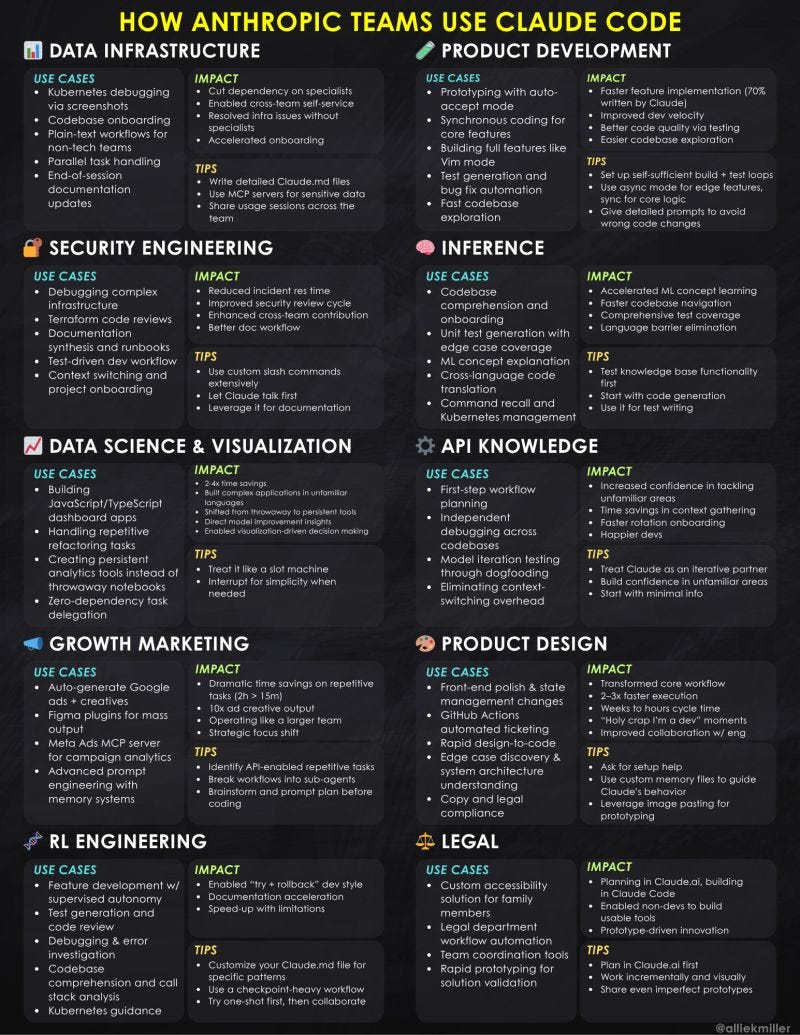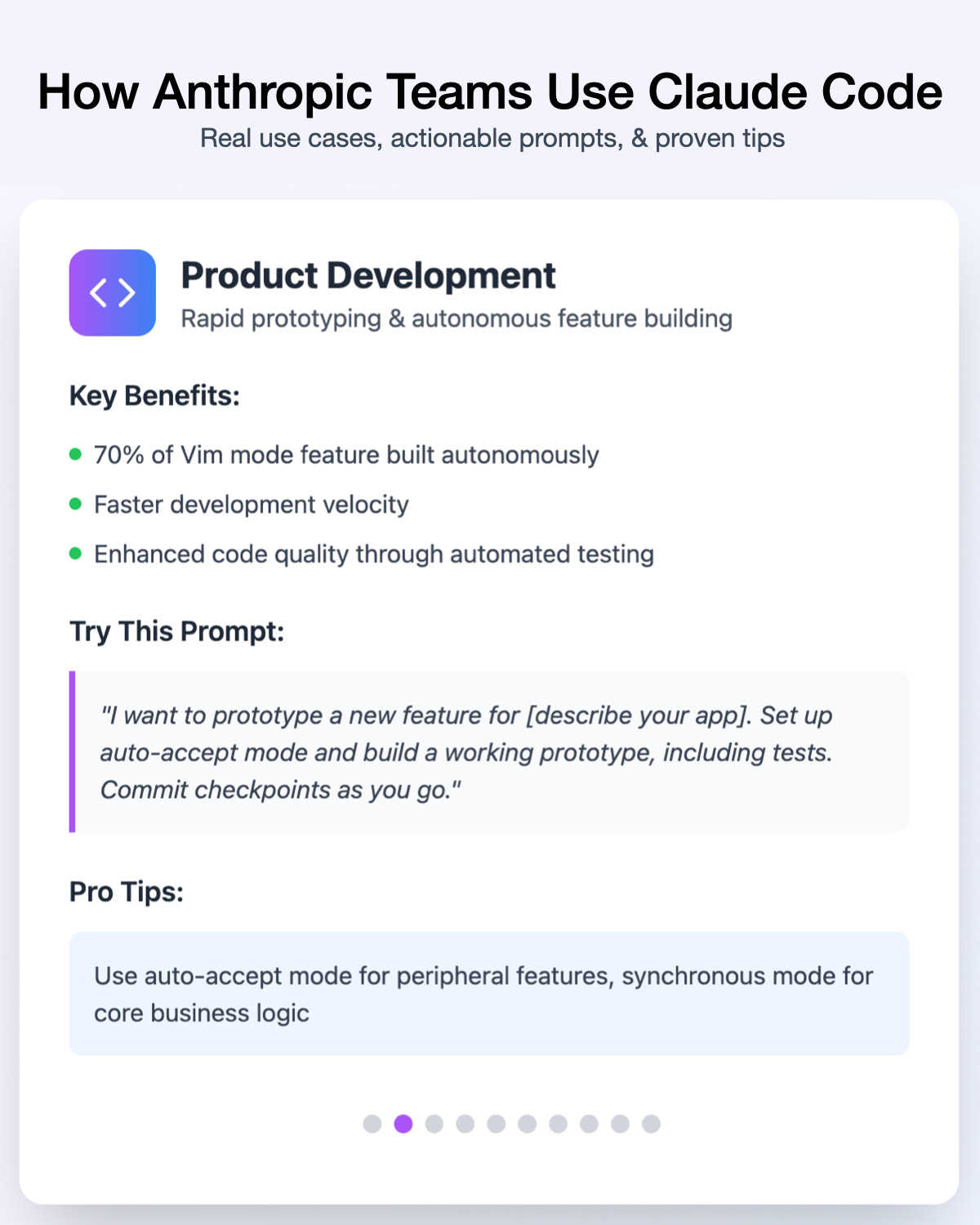How Anthropic Teams Use Claude Code
(& how it's relevant in the Real-World for Creatives) - Fair warning, this post is LONG!
Allie K. Miller shared a post a week ago on this topic, and shared a a helpful one-pager breaking down all the use cases that Anthopic shared in their PDF.
Here's Allie's one-pager:
Her post was in relation to the document that Anthopic put out - 'How Anthropic teams use Claude Code.'
But my audience–like me–are mostly Creative Professionals. In all my life, I have never used the word kubernetes (until just then)–and thought as awesome as this paper might be, if it is not made relevant–it will do my audience and creative friends NO good.
So, I decided to do something a little bit different. I want to share a summarized version of the 10 key takeaways that the Anthropic team found indispensable–then share after each one of those a way to make it super relevant to you.
I dare you to find a way to use the word kubernete in a sentence today. So, what the heck is that anyway?
Data Infrastructure and Kubernetes are essentially fancy ways of saying "keeping all your creative files, processes, and workflows organized and running smoothly." Think of Kubernetes like having a super-organized studio manager who automatically makes sure all your projects have the right resources, deadlines are met, and nothing crashes when you're on a tight deadline.
The Real-World Creative Equivalent? (Or - what this actually does)
Instead of: "Resolved Kubernetes issues without specialists"
→ you might say: Fixes corrupt files & speeds up workflows without calling IT
Instead of: "Enabled finance teams to execute complex workflows"
→ you might say: Streamlines client approval processes so campaigns move faster.
Instead of: "Accelerated new hire onboarding"
→ you might say: Gets new team members working with brand assets immediately.
Why creatives care: Your creative tools and files just work. No crashes during deadline crunches, no waiting for IT to fix things, no manually organizing project folders for the hundredth time.
Try this prompt:
"I have a creative project management issue - client revisions are getting lost between team members and we're missing deadlines because assets aren't syncing properly. Can you help me diagnose this using project screenshots and guide me through organizing our creative workflow?"Creative Translation: PRODUCT DEVELOPMENT for Creatives
Let’s be real—most creatives don’t build codebases.
But we do build systems: Campaigns, style guides, templates, workflows, brand kits, repeatable content engines.
Think of “Product Development” like creative R&D. It’s how you build smarter, reusable assets that make your next project 10x easier.
The Real-World Creative Equivalent?
Instead of: Prototyping with auto-accept mode
Think: Instantly previewing 6 campaign mockups before coffee.
Instead of: Syncing code for core features
Think: Updating brand guidelines across every template in seconds.
Instead of: Bug fixing automation
Think: Auto-flagging design inconsistencies before your client does.
Why creatives should care: This is how you stop reinventing the wheel and start scaling your brilliance.
Using GenAI like Claude can help you:
Generate multiple creative variations fast
Refine your process with fewer revisions
Build reusable templates, decks, or kits that your team (or clients) can remix with ease
Spot workflow bottlenecks before they cost you time
Try this prompt:
“I’m building a reusable campaign kit for my client that includes headlines, social post variants, and design templates. Can you help me structure this system so it’s easy to update in the future and scales across multiple platforms without breaking brand consistency?”Pro Tips:
Use Claude to prototype workflows, not just outputs
Ask it to stress test your creative process (e.g., “Where might this system break if we scale from 3 to 30 posts a week?”)
Build once, remix forever
Security Engineering sounds like a department where everything’s locked down tighter than a Dropbox folder from 2012. But in the creative world, it’s more like quality control, file integrity, and team accountability.
It’s about preventing the chaos before it happens—and recovering quickly when it does.
Real-World Creative Equivalent:
Instead of: Debugging infrastructure
Think: Figuring out why your brand guide didn’t export correctly (again).
Instead of: Security audits
Think: Making sure the final-final version didn’t accidentally get overwritten by “v4b_rev-final_REALLYthisone”
Instead of: Faster Terraform reviews
Think: Claude helping double-check your style guide for consistency before the client sees it.
Why creatives should care: Because nothing kills momentum like opening a file to find it’s corrupt, outdated, or mysteriously missing. Claude can:
Track issues in your asset pipeline
Diagnose version control chaos
Ensure your final file is actually… final
Catch inconsistencies across campaign assets
Try this prompt:
“Here are the last 3 versions of a campaign file. We’re seeing inconsistencies in font, spacing, and color usage between them. Can you help us identify what changed, flag inconsistencies, and recommend a cleanup workflow to avoid this in the future?”Pro Tips:
Let Claude audit your creative workflow for vulnerabilities
Use it for automated quality checks on deliverables
Set up “creative smoke tests” before files go client-side
“Inference” may sound like robots figuring out their feelings, but for creatives it’s simply making sense of complex assets and processes—from dissecting a sprawling brand library to auto-generating test cases for your design systems.
It’s the AI equivalent of your sharpest team member who:
Teaches new hires the ropes in minutes
Spots errors you didn’t even know existed
Translates your style guide into every file format
Real-World Creative Equivalent:
Instead of: Codebase comprehension
Think: Instantly understanding a massive Figma library you just inherited.
Instead of: Unit test generation
Think: Auto-checking every slide in your deck for correct logo usage and color codes.
Instead of: Cross-language code translation
Think: Converting your brand assets and copy into multiple languages and formats—without manual rework.
Why Creatives Should Care:
Because when you inherit a giant, tangled project—or need to spin it up from scratch—Claude can:
Map out your entire asset structure in plain English
Generate checklists or “tests” for every design element
Explain complex guidelines in creative terms
Suggest fixes and spot missing pieces before launch
Try This Prompt :
“I’ve inherited this 200-slide deck with inconsistent typography, colors, and image treatments. Can you analyze the files, summarize the key style rules you find, and generate a checklist to automate QA across the deck?”Pro Tips:
Use Claude to educate new team members by auto-generating onboarding guides from your existing assets
Combine explanation + verification: “Explain this file structure” then “Check these 10 rules”
Leverage inference to translate brand guidelines into actionable tasks or scripts for your workflow tools.
Keep reading with a 7-day free trial
Subscribe to AI Lab to keep reading this post and get 7 days of free access to the full post archives.











